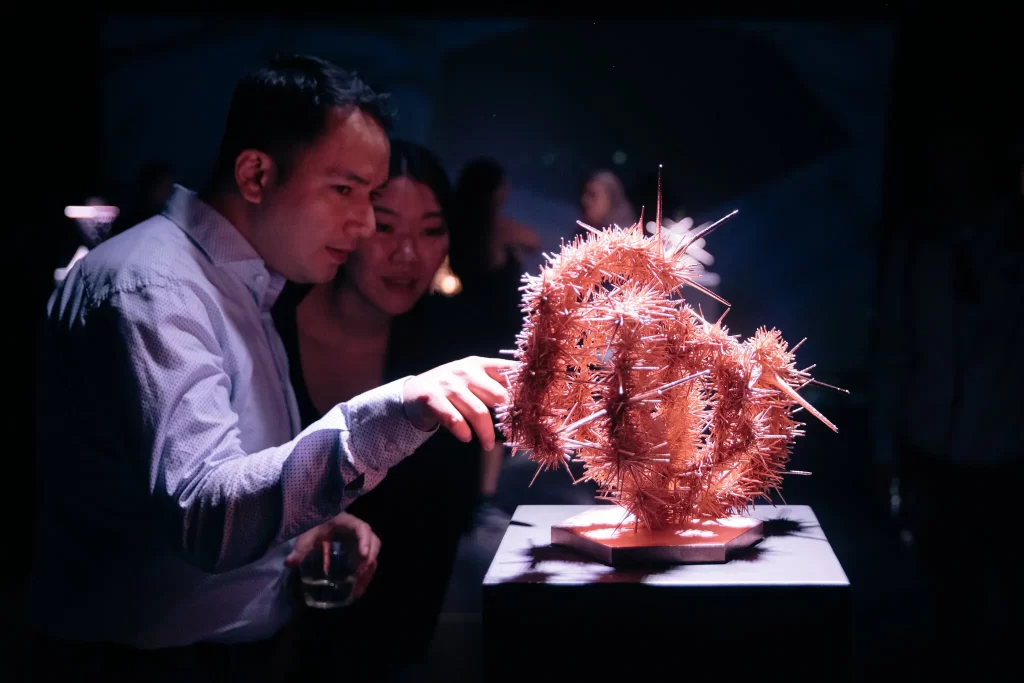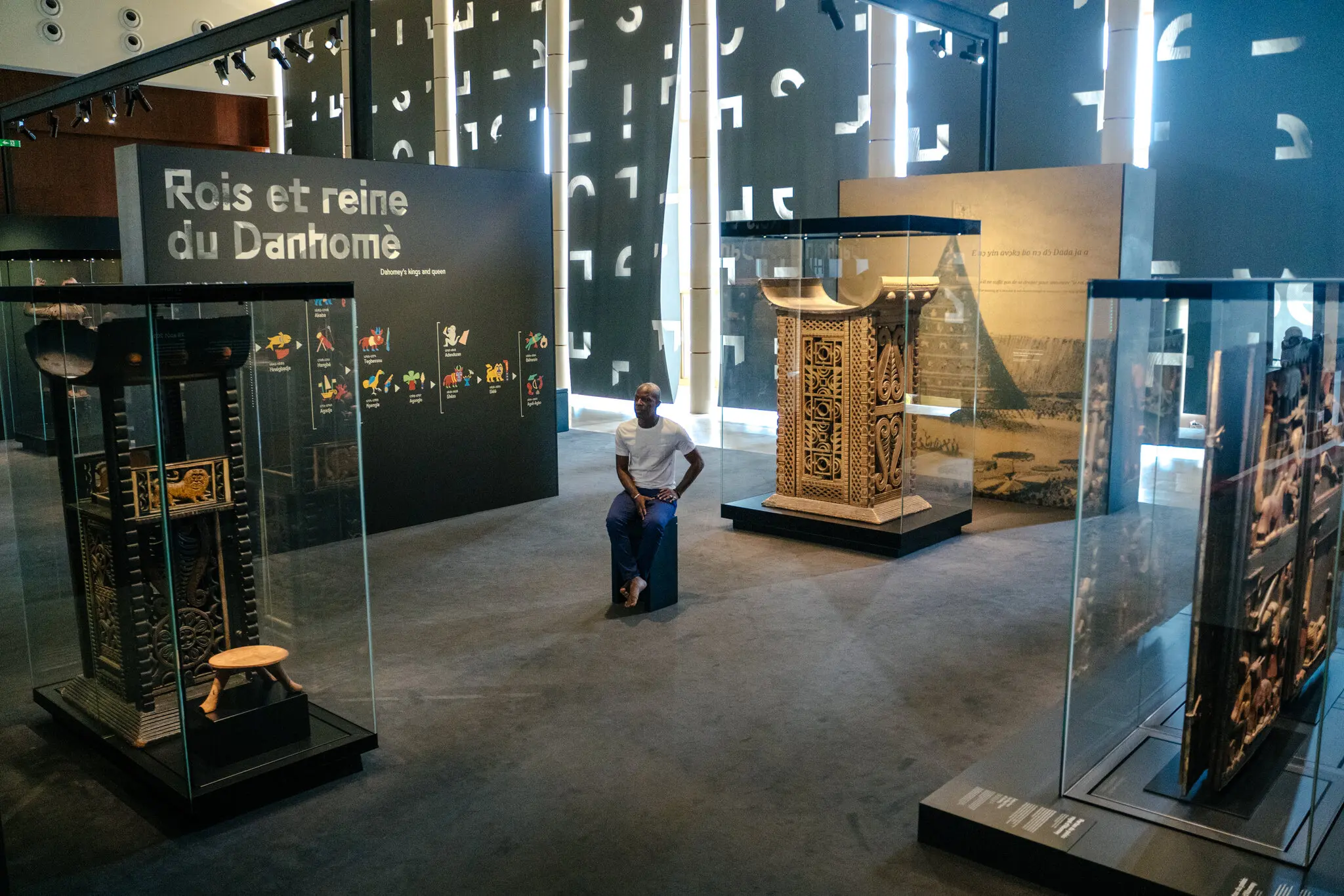
In Carl Sagan’s classic sci-fi novel “Contact,” the first signals from alien life were famously heard at Hat Creek Radio Observatory at the SETI Institute (Search for Extraterrestrial Intelligence) in Northern California. For an artist with a lifelong interest in science, there may not be a more ideal scenario than hobnobbing with NASA scientists at a picnic at SETI, which is where the Brooklyn-based artist Ashley Zelinskie made “first contact” with her friends at NASA — many of whom have become close collaborators.
The picnic at SETI garnered Zelinskie invitations to tour NASA’s nearby Ames Research Center and to a rocket launch at Kennedy Space Center in Cape Canaveral, Fla., in 2016, which led her to the James Webb Space Telescope team at Goddard Space Flight Center in Maryland. In July, the Webb, the largest-ever space telescope, enthralled both scientists and the public with spectacular glimpses of never-before-seen nebulas, exoplanets, ancient galaxies, and fluffy translucent clouds of space dust swirling around shimmering stars.
Working closely with various NASA scientists over the last seven years, Zelinskie, a self-described “science nerd,” has produced a range of art — among them several pieces taken directly from the Webb’s groundbreaking first images. These works — including 3-D-printed sculptures, a VR installation, and a screen print augmented with interactive lights — are featured at the show “Unfolding the Universe: First Light,” on view through Oct. 23 at ONX Studio, a performance and exhibition space in Midtown Manhattan that is a partnership of the Onassis Foundation and New Inc, the New Museum’s art and tech incubator.

Center and right, Ashley Zelinskie’s “Deep field [lite brite],” a silk-screen print from 2022, and “Deep field” in “Unfolding the Universe: First Light.” Jeenah Moon for The New York Times

A guest puts a lite brite on Zelinskie’s “Deep field [lite brite],” at ONX Studio. Jeenah Moon for The New York Times
These collaborations are a two-way street: The artist gets access to a well of inspiration, while the scientists enjoy seeing their life’s work reach new audiences. Zelinskie helps interpret the scientific process in her artworks, while scientists give feedback on the integrity of each piece. “I try to do my research and understand their careers and work so I can understand the science they are trying to teach me,” Zelinskie said. “I wish these subjects weren’t so separate.”
When she saw the process that NASA’s “space visuals developers” used to create images from working on the Webb’s first deep field images with multiple wavelengths, layered in color channels, Zelinskie realized the process mirrored that of making a traditional silk-screen with four layers — white, yellow, red and blue — applied one at a time. For the interactive pegboard “Deep Field,” she used digital files of each different wavelength to create the layers for the printed silk-screen, which visitors can augment with small plastic colored pegs, mimicking the process of finding new stars in the dark spots of deep space.
The artworks take cues from Pop Art, like the halftone screen-prints that recall Warhol, or recognizable, figural sculptures like “Ring Nebula,” which recreates the Southern Ring Nebula in a 3D-printed “cloud” of copper around two aquamarine gems representing the two stars in the center that are ejecting dust and gas. Zelinski is careful to toe the line between abstraction and a more traditional science display like those in a museum or visitors center. “Scientists can be very analytical and didactic,” she said. “I am always pushing to make things more creative, without losing the educational thread.”

Ashley Zelinskie’s “Exploration,” a 3-D printed sculpture coated in the same gold as the Webb Telescope, in “Unfolding the Universe” at ONX Studio in Manhattan. Jeenah Moon for The New York Times

Zelinskie’s “Ring Nebula,” which recreates the Southern Ring Nebula in a 3D-printed “cloud” of copper, at ONX Studio in Manhattan. Jeenah Moon for The New York Times
Maggie Masetti, curator of the exhibition at ONX and social media lead and website manager for the Webb, says that for NASA’s teams, art is another way to reach bigger and more diverse audiences. After seeing the passionate followings that artists have on social media, Masetti invited several to see the Webb up close and create art, which turned into an exhibition in the visitors center at Goddard. “The telescope is absolutely beautiful,” she said. “It has this enormous gold coated mirror, which is great at reflecting infrared light, but it is also an incredible aesthetic object.”
To commemorate the launching of the Webb on Christmas Day 2021, Zelinskie worked with Masetti and NASA’s Webb Telescope team to develop an immersive digital space using the Mozilla Hubs, a web application accessible on both desktop and mobile. Scientists from the Webb team joined in the VR launch event simultaneously with the real launch on Christmas Day 2021. They hosted Q. and A.’s with scientists and people around the world. An updated version of the virtual world is on display at ONX with soundscapes of interviews with the Webb scientists.
John Mather, a senior project scientist on Webb who also won a Nobel Prize for his work on the Big Bang, did one of those Q. and A.’s as an avatar and people around the world were asking him questions. He, Zelinskie and Amber Straughn, an astrophysicist at the Goddard Space Flight Center, had their hands 3-D scanned for “Exploration,” a sculpture that depicts the Webb telescope with three hands extending outward. After Zelinskie’s model was 3-D printed, it was coated in the same gold as the Webb itself.

Center, Dr. Knicole Colón, an astrophysicist with NASA, looks at Ashley Zelinskie’s “Space Time” (2022) at ONX Studio. Left, the curator of the show, Maggie Masetti. Jeenah Moon for The New York Times
Reinforcing the importance of education and outreach, Mather says that sharing these findings with people is what inspires him to keep going with his work. “We are exploring the universe by taking pictures and telling stories about what those pictures mean,” he said. “I always like to say, ‘The public paid for this, let’s all enjoy it together.’”
What’s next for NASA’s team and Zelinskie? A collaboration between the artist and retired astronaut Mike Massimino. Their exhibition will focus on the human experience of being in space, and features computer-guided milled marble replicas of Massimino’s gloves, as well as a 3-D-printed version of his helmet, with real helmet cam footage projected onto the visor. “We see things in a different way,” Massimino said, “Ashley brings out the artistic side of what we do.”
Unfolding the Universe: First Light
Through Oct. 23, ONX Studio, Gallery Level, Olympic Tower, 645 Fifth Avenue, (212) 486-8531; onx.studio.
FEATURED IMAGE: Visitors to the ONX Studio in Manhattan with Ashley Zelinskie’s “Ring Nebula” (2022), a 3-D printed sculpture, during the exhibition “Unfolding the Universe.” Jeenah Moon for The New York Times




